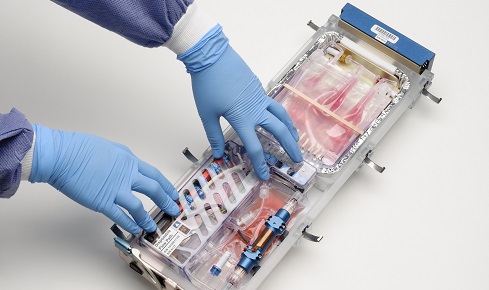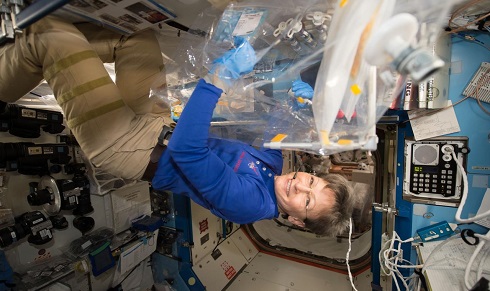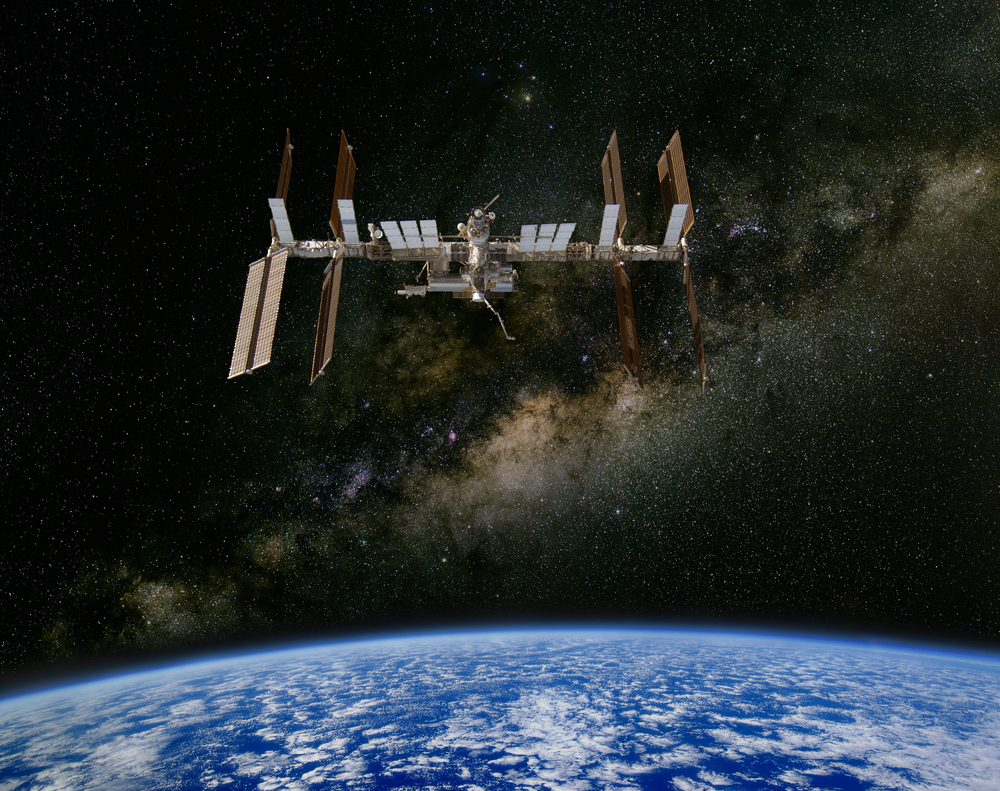A giant leap for bioscience

The unique conditions on board the International Space Station are proving to be an excellent environment for studying stem cells, organoids and tissue regeneration, writes Payal Dhar
September 12th 2022
As a little girl Catriona Jamieson was fascinated by space, watching Star Trek and wondering about the secrets of that uncharted final frontier. Little did she know what an important role space would play in her work decades later. Jamieson is now a physician, professor of medicine and director of the Sanford Stem Cell Clinical Center at the University of California San Diego (UCSD), and in recent years her research group has been studying how human stem cells behave in space.
In orbit a combination of factors, including microgravity and increased ionising radiation, affect fundamental biological processes. Weightlessness causes significant mechanical ‘unloading’ of mammalian tissues, and the degenerative effects of spaceflight include bone and muscle loss, decreased cardiovascular capacity, defects in wound and bone fracture healing, and impaired immune function. Crucially, space also causes cells to grow and age much faster than they would on Earth, enabling scientists to study the changes related to ageing and disease progression in fast-forward.
A lab like no other
Jamieson specialises in myeloproliferative disorders, a suite of health problems that cause an overproduction of blood cells and can lead to heart attacks, deep vein thrombosis, pulmonary clots and the development of leukaemias. As someone interested in finding targeted stem cell therapies for such disorders, the International Space Station (ISS) provides Jamieson, and others like her, with a unique laboratory environment to study and grow stem cells.
 An incubator cassette from a bioculture system sent up to the ISS. (Image: NASA).
An incubator cassette from a bioculture system sent up to the ISS. (Image: NASA). Jamieson’s lab has recently sent its third experiment to the ISS, which orbits almost 400km above the surface of the Earth. The first, which went up in December 2021, contained normal haematopoietic (blood-forming) stem cells. The changes observed in these cells in one month on board the ISS would have taken up to 10 years on Earth, Jamieson says.
The second, sent up in April 2022, studied tumour organoids and leukaemia cells. The team used fluorescent reporters in a special bioreactor adapted for space to watch how the cells behaved and where they were in the cell cycle. “We saw that the organoids expanded in size substantially, tripling in size on the ISS within five days,” Jamieson says. In the leukaemia cells, self-renewal genes that were activated by the stress of spaceflight appear to be a “rocket fuel for cancer”, says Jamieson. “By understanding the stepwise development of cancer at the stem cell level, we’re going to make massive inroads into predicting and preventing cancer progression,” she says. The third experiment, which is scheduled for this summer, also contains normal haematopoietic stem cells. “It’s the same as the [experiment] we did originally, but it’s just about getting more experienced doing this and to see if we see the same extraordinary changes that we saw on the original mission.”
The ISS has been home to a number of stem-cell-related experiments over the past decade, one of the first being a study by NASA’s Ames Research Center on the effects of microgravity in tissue regeneration. The first human stem-cell-derived heart cells were sent up to space in 2016, and more recently, in March 2020, researchers from the University of Zurich sent up a payload of 250 test tubes, containing stem cells for bone, cartilage and other tissues, to study the advantages of growing human tissue in microgravity for use in precision regenerative medicine.
In 2020 brain cells from patients with Parkinson’s disease and multiple sclerosis were blasted into low orbit for a range of experiments focused on neurodegenerative disease. That same year the Sanford Stem Cell Clinical Center at UCSD and aerospace engineering company Space Tango began working on a dedicated orbital stem cell lab on board the ISS. The idea is to have an integrated space stem cell research laboratory with dedicated equipment and crew time in the hope of modelling disease and developing therapies in orbit. Space Tango’s specialised automated platforms aim to make it easier for researchers on Earth to perform and adjust experiments while in space.
Focus on physiology
The altered conditions in space have been shown to cause a range of surprising changes to the human body, including accelerating ageing, even at the relatively low orbit of the ISS. The famous NASA Twin Study, an experiment involving identical twin astronauts Mark and Scott Kelly, found significant and worrying differences in the physiology of the twin who spent a year in space.
 NASA astronaut Peggy Whitson works on cell transfers as part of an investigation on cardiac myocytes investigation on the International Space Station. (Image: NASA)
NASA astronaut Peggy Whitson works on cell transfers as part of an investigation on cardiac myocytes investigation on the International Space Station. (Image: NASA)Researchers conducted identical biomedical studies on both twins while Scott spent a year on the ISS and Mark remained on Earth. While some functions were not affected, such as immune response to vaccination, there were significant changes of other kinds, including telomere length, gene regulation, gut microbiome composition, body weight and carotid artery dimensions. Some of these reversed after returning to Earth, but others persisted even after six months, including the shortened telomeres, DNA damage and altered gene expression levels.
“Scott Kelly … came back with precancerous changes in his blood,” Jamieson says, “with the kind of immune system changes that we see when people get older. That kind of immune dysregulation sets people up for severe viral infections… But it [also] helps us to understand how the blood regulates its capacity to give rise to immune cells in response to viruses as we age. It tells us how clonal mutations occur in the blood and in what sequence as we age, and similarly for the liver and the brain.”
Organoids in orbit
Alysson Muotri is a professor of paediatrics and cellular and molecular medicine at UCSD. He is also director of its Institute for Genomic Medicine and studies the development of the human brain. Muotri is studying brain stem cell regeneration and repair via experiments on the ISS’s new stem cell laboratory. The groundbreaking experiment will evaluate the affect of space on more than 100 brain organoids while in orbit.
In previous experiments changes in gene expressions and morphology were seen in brain organoids after just 30 days in low Earth orbit (LEO). In Muotri’s estimation, one month in microgravity sped up the ageing process by five to 10 years in the organoids in terms of the gene expression and methylation status of their DNA.
However, performing experiments in space is not simple. Muotri’s laboratory’s second payload, sent to the ISS in December 2020, developed a leak and the experiment ended in failure. Experiments scheduled for 2021 were also subject to various delays. Finally, on 14 July 2022, the third payload from the lab, a redesigned version of earlier ones, reached the ISS. “This time we can not only validate [the results of the first experiment], we can also dig a little bit more into the mechanisms of how the neurons senesce,” he says.
 Long term biomanufacturing facilities may be developed to grow cells and tissue in low orbit.
Long term biomanufacturing facilities may be developed to grow cells and tissue in low orbit. According to observations from the first payload the ageing seems to be related to telomerase, an enzyme located in human chromosomes that maintains the length of telomeres. Shorter telomeres are associated with ageing and disease. Muotri’s team have engineered some of the organoids to have different telomere sizes to help understand the effects of microgravity. He says: “My hypothesis [is that] in microgravity, the binding of the telomere protein with the DNA is different from what we see on Earth and that’s what causes this type of accelerated ageing.”Things are going well with the latest experiment. “We just collected the first images and videos showing them surviving and developing beautifully,” Muotri writes in an email update. “I can’t wait to see how they look in a month or so.”
Commercial opportunities
The long-term goal of experimentation on board the ISS is to make this unique platform more accessible for disease modelling. The experiments are also generating useful data on the effects of prolonged spaceflight on astronauts. This becomes particularly relevant given NASA’s plans to send humans to cislunar environments (between Earth and the moon) and preparation for missions further away, such as to Mars, where crew will be exposed to high radiation, solar particle emissions and microgravity for longer periods than is usual.
Such are the advantages of growing and studying stem cells and stem-cell-based tissues in space, there are even plans to create long-term biomanufacturing facilities there to generate biomaterials for use in medicine. “I think there’s an opportunity to commercialise this environment, over 200 miles above Earth, to use that unique environment to make, for example, some small molecules more effectively to inhibit cancer, and to develop new therapies that expand stem cell populations,” says Jamieson.
The commercialisation of space, the proliferation of private companies offering spaceflight services and government initiatives to boost this sector are all helping LEO to become the world’s ‘next nexus of biotechnology’ – albeit one that is technically only just on this planet.
Payal Dhar is a freelance science writer from Bangalore covering science and technology.


